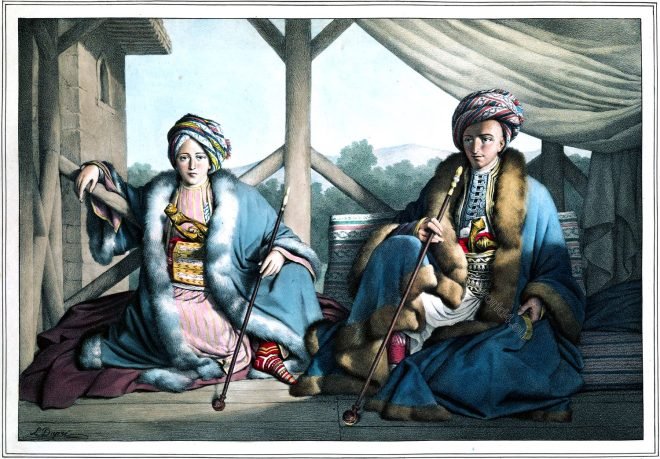Scutari cemetry of Istanbul, the former Constantinople. Among the objects which distinguish a Turkish necropolis, is the stone placed to mark the grave.
Category: Ottoman Empire
Ottoman Empire Costumes. Traditional Ottoman Folk Costumes, The Janissaries uniforms, Turkish Sultans. Turkish Military Costumes. Traditional Turkish Men`s and women`s dresses.
The Kiz Koulasi. Leander’s, or The Maiden’s Tower on the Bosporus.
The Kız Kulesi is now used as a beacon for ships entering the strait, and boats passing the estuary.
The Theodosian Walls. The Triple Wall of Constantinople.
The Triple Wall of Constantinople. On the Land side, near Top Kapousi. Constantinople and its environs.
The Cistern of Binbirdirek called the Thousand and One Pillars.
The Cistern of Binbirdirek or Cistern of Philoxenos called the Thousand and One Pillars is a man-made subterranean reservoir in Istanbul.
Ismail Bey and Mehmed Pasha. Portraits of Louis Dupré c. 1819.
Ismail Bey and Mehmed Pasha, sons of Veli Pasha of Thessaly and grandsons of Ali Pasha of Ioannina.
Masterpieces of Turkish nomad carpets of the 18th c.
Turkish nomad carpets made by nomad tribes throughout the Ottoman empire, known generally as Smyrna carpets. The women mostly working on them in winter.
FAR-A WAY-MOSES. Jewish type. Dragoman.
The above portrait is another illustration of the persistence of the Jewish type.
Costumes of the Ottoman court. Cara Coulouktjou, Ousta, 1850.
The motifs show costumes of the Ottoman court during the reign of Mahmoud II. Elbicei Atika was the name of a costume museum in Constantinople, originally located in the armoury of the Seraglio.
Basch Tshaousch, Kol Kiayassi. Costumes of the Ottoman Court.
Basch Tshaousch. Costumes of the Ottoman Court, 1850. Various Ottoman functionaries and military personnel in their traditional costumes.
Bach Tchohadar, Silihtar Aga, Peik, Solak.
Bach Tchohadar, Silihtar Aga, Peik, Solak. Ottoman Empire 1856. Various Ottoman functionaries and military personnel in their traditional costumes.










